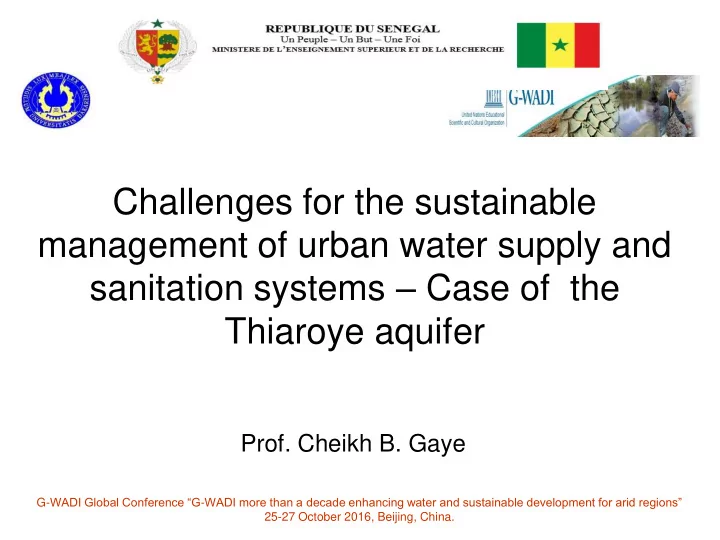

Challenges for the sustainable management of urban water supply and sanitation systems – Case of the Thiaroye aquifer Prof. Cheikh B. Gaye G- WADI Global Conference “G - WADI more than a decade enhancing water and sustainable development for arid regions” 25-27 October 2016, Beijing, China.
Introduction Groundwater as an important part of the Water Cycle Groundwater stored = Water resources inherited from the past millennia
Aquifers main functions Storage capacity (storage coefficient or specific yield) Transfer capacity (transmissivity) • Physical and chemical interaction capacity (reservoir- rock vs GW)
Importance of Groundwater for Africa • Key source of water for drinking (urban & rural supplies), livestock, and small scale irrigation • Approximately half of the nearly one billion people in Africa rely upon groundwater for their daily water supply • Has enabled communities across Africa to adapt to seasonal or perennial shortages in surface water • Is indispensable when managing water scarcity, a natural condition in 30 out of 53 African countries. • Groundwater management is fundamental to effective river basin management e.g 80 % of the Niger River water is from groundwater.
Groundwater resources at risk Groundwater pollution in Lusaka City, Zambia How to supply potable water here? Groundwater aquifers that supply many African mega cities are often heavily polluted (e.g. Dakar, Abidjan, Lagos, Accra, Lomé, Lusaka, Adis Ababa)
The water supply of Dakar Daily production : 350000 m 3 / j • 7% s from local aquifers (2% Thiaroye – shallow sand, 5% NIB - volcanic); • 39% derives from surface water from Lac de Guiers (23% - KMS, 16% is Nguith) and • the remaining 54% derives from northern littoral (coastal) aquifers (19% from sandy aquifer Littoral North and Kell; 35% from Horst sand aquifer and surrounded by Paleocene limestone)
Thiaroye aquifer - show case of aquifer eutrophication High rate of urbanization critical problems in providing adequate water supply and sanitation systems Soudano-sahalien climate 14 ° 25 ’ et 15 ° 5 ’ N It extends as a peninsula 50 km with Oceanic Influence 16 ° 55 ’ et 17 ° 32 W in the W-N Direction
Study Stud y ar area ea GEOLOGY / GEOMORPHOLOGY Senegal-Mauritanian sedimentary basin / Tertiary igneous rocks covered by Quaternary sediments - Depressed area between the Extreme westward peninsula with an uplift of the ± 105m sedimentary deposits (105m) and the cliff of Ndiass (127m) ± 127m Elevations of the Cap-vert peninsula (SRTM-USGS / NASA) studied hydraulic system is the Thiaroye unconfined quaternary sand HYDROGEOLOGY aquifer, located between Dakar and Kayar on approximately 300 Km 2 8
ENVIRONMENTAL SETTING Stud Study y ar area ea Thiaroye peri -urban area Coastal zone & Lac Retba 9
Hundreds of thousands of septic tanks and a major municipal landfills Mbeubeuss Drainage and waste
Fertilizers and pesticides use in the practice of urban agriculture. Groundwater quality has deteriorated substantially with nitrate concentrations in excess of 500 mg·L -1 where on-site sanitation facilities dominate
Geochemical indicators to assess the impact of urbanization on groundwater quality. EC: significant variability 222 to 4480 µS/cm which differentiate : Saline waters High EC (1100 ˂ CE ˂ 4480 µS/cm) Na-Cl or Na/Ca-Cl Water types Relative abundance of ions : Cations: Na + > Ca + > Mg + > K + ; Anions: Cl - > SO 4 2- > HCO 3 - Highly NO 3 content up to 500 mg/L Represented in the peri – urban area impacted by anthropogenic effects Saline waters enriched in both Cl and SO4 in the coastal zone Fresh waters EC (222 ˂ CE ˂ 884 µS/cm) Groundwater is predominantly Ca – HCO3 facies and correspond to the discharge zone
Geochemical indicators to assess the impact of urbanization on groundwater quality.
Geochemical indicators to assess the impact of urbanization on groundwater quality. 3 H Contents measured in groundwater and rainwater (2008) Rainwater Groundwater replenished by • 1.5 to 2.8 ± 0.7 UT rainwater prior to the 1960’s • Mean = 2.25 UT (Considered as Input signal) is supposed to have very low Groundwater H values • 1.1 < 3 H < 3.5 UT 78% • < 1 UT 7% • 4 < 3 H < 5.3 UT 25% 93 % of the sampled groundwater have a modern component while 7 % appear not to have been affected by recent recharge
Eutrophication resulted in drastic decrease of exploitation rate Changes in the exploitation of the Thiaroye aquifer due to increase in nitrate content for the period 1952 - 2011
Urban flooding with rise in groundwater level due to the lowering of the pumping rate; and contribution from rain-fed recharge and septic effluent to urban groundwater budget
Conclusion • Adaptive responses to urban groundwater contamination through the importation of water from less- polluted environments but such solutions are constrained not only by the availability of water from remote locations but also the costs of doing so.
• Need to better understand the contamination process in order to elaborate groundwater resource management and protection strategies of the urban groundwater. This will serve as a decision support system for planning future habitat settlements around the capital city and other big cities, and promulgate and enforce regulation and policies for building adequate sanitation infrastructure as well as installing a working system for disposal of solid wastes .
• Results can be potentially replicated in other fast growing cities and used as methodology approach to evaluate the real environmental impact on the quality of groundwater resource particularly in developing countries characterised by burgeoning informal settlements and inadequate sanitation infrastructure.
Afr AfriW iWatSan tSan AfriWatSan five years research project funded by the Royal Society / DFID (2015 – 2020) Scientific evidence required to inform policies and practices that sustain the quantity and quality of urban low cost water supply and sanitation systems exploiting the sub-surface in Sub-Saharan Africa Urban Groundwater Observatory
Thank you
Recommend
More recommend